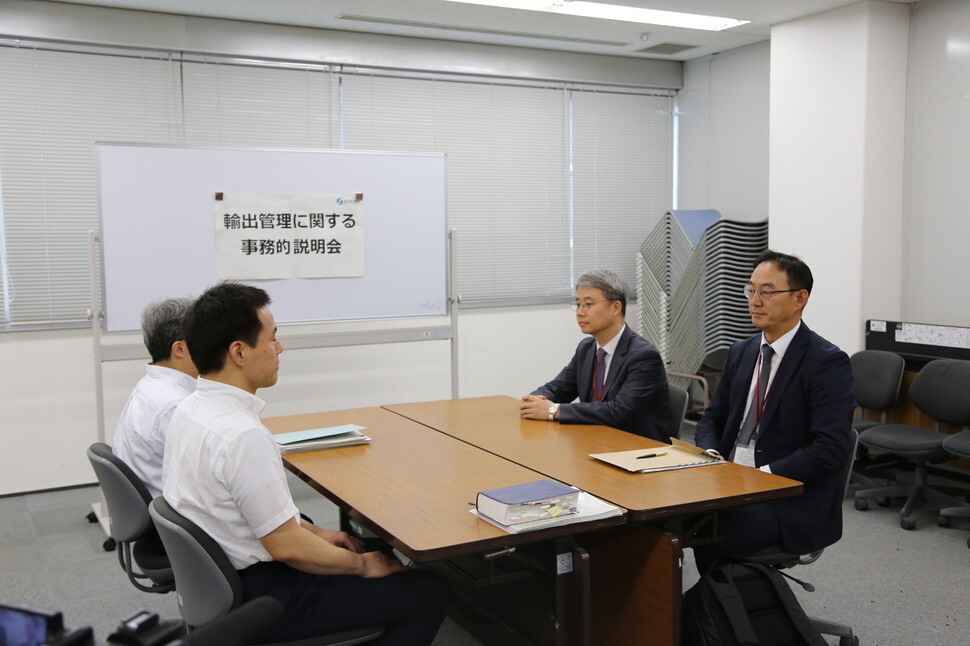hankyoreh
Links to other country sites 다른 나라 사이트 링크
S. Korea, Japan hold talks on export controls at director-general level for 10 hours in Tokyo

A bureau director-level policy dialogue lasting over 10 hours was held in Tokyo on Dec. 16 in an attempt to resolve the conflict that erupted between Seoul and Tokyo over Japan’s imposition of stiffer export controls against South Korea last July. It was the first export management policy dialogue held to discuss export controls on strategic items since June 2016.
The policy dialogue, which kicked off at the Ministry of Economy, Trade, and Industry (METI) around 10 am on Monday, continued well past the scheduled endpoint of 5 pm, until 8:18 pm, in a marathon session. The mood during this round of dialogue was more amicable than the rancorous working-level talks between section heads this past July.
When Lee Ho-hyeon, director-general of trade policy for South Korea’s Ministry of Trade, Industry, and Energy (MOTIE), entered the meeting room, Yoichi Ida, director-general of the trade control department at METI, was waiting to greet him. Lee extended a friendly greeting to his counterpart upon entering, and the two shook hands with a courteous smile. During the meeting between section chiefs, also held at the METI this past July, the two sides didn’t even exchange greetings in front of reporters.

The meeting between director-generals took place in a spacious conference room, capable of seating more than 20 people, with coffee and water provided to those in attendance. Eyebrows had been raised when the section chief meeting was held in a disorderly room, where the chairs hadn’t even been laid out.
This past July, the Japanese government imposed controls on exports of three materials used to manufacture semiconductors and displays in what was effectively payback for a ruling by the South Korean Supreme Court that ordered Japanese companies to compensate victims of forced labor during Japan’s colonial occupation of Korea. Then in August, Japan removed South Korea from its “white list” of trading partners that benefit from a streamlined screening process for dual-use exports. The ostensible rationale the Japanese government provided for those measures is what it describes as the weakness of South Korea’s export management system, including the failure to hold bilateral policy meetings for some time, the inadequacy of “catch all” restrictions on dual-use materials, and a shortage of staff.

During the daily press briefing on the morning of Dec. 16, while the meeting between director-generals was underway, Japanese Chief Cabinet Secretary Yoshihide Suga repeated Japan’s basic position. “Japan intends to operate [its export controls] according to a comprehensive assessment of the other country’s export management. This isn’t the sort of matter that can be decided through deliberations with the other country,” he said.
By Cho Ki-weon, Tokyo correspondent, and Kim So-youn, staff reporter
Please direct comments or questions to [english@hani.co.kr]

Editorial・opinion
![[Column] The state is back — but is it in business? [Column] The state is back — but is it in business?](https://flexible.img.hani.co.kr/flexible/normal/500/300/imgdb/original/2024/0506/8217149564092725.jpg) [Column] The state is back — but is it in business?
[Column] The state is back — but is it in business?![[Column] Life on our Trisolaris [Column] Life on our Trisolaris](https://flexible.img.hani.co.kr/flexible/normal/500/300/imgdb/original/2024/0505/4817148682278544.jpg) [Column] Life on our Trisolaris
[Column] Life on our Trisolaris- [Editorial] Penalties for airing allegations against Korea’s first lady endanger free press
- [Editorial] Yoon must halt procurement of SM-3 interceptor missiles
- [Guest essay] Maybe Korea’s rapid population decline is an opportunity, not a crisis
- [Column] Can Yoon steer diplomacy with Russia, China back on track?
- [Column] Season 2 of special prosecutor probe may be coming to Korea soon
- [Column] Park Geun-hye déjà vu in Yoon Suk-yeol
- [Editorial] New weight of N. Korea’s nuclear threats makes dialogue all the more urgent
- [Guest essay] The real reason Korea’s new right wants to dub Rhee a founding father
Most viewed articles
- 1[Column] Why Korea’s hard right is fated to lose
- 2Amid US-China clash, Korea must remember its failures in the 19th century, advises scholar
- 360% of young Koreans see no need to have kids after marriage
- 4[Column] The state is back — but is it in business?
- 5Hybe-Ador dispute shines light on pervasive issues behind K-pop’s tidy facade
- 6[Column] Can Yoon steer diplomacy with Russia, China back on track?
- 7Inside the law for a special counsel probe over a Korean Marine’s death
- 8Japan says it’s not pressuring Naver to sell Line, but Korean insiders say otherwise
- 9[Editorial] Penalties for airing allegations against Korea’s first lady endanger free press
- 10Presidential office warns of veto in response to opposition passing special counsel probe act